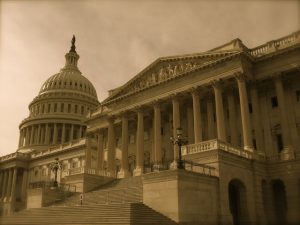By Stephen S. Fuller, Ph.D.
Download as a PDF›

At $500 billion, the Washington region’s economy ranked 5th in size in 2016 among the nation’s metropolitan areas. While this economic scale would seem sufficient to protect the region from the downdraft from reduced federal spending this may not be the case. Recent history confirmed the region’s economic vulnerability. The federal spending reductions during FY 2014 due to the Sequester brought the region’s economy to its knees. The economy declined 0.5% in 2013. The District of Columbia economy contracted in 2013 and so did suburban Maryland’s; Northern Virginia’s contracted in 2014. Job growth in 2014 totaled only 18,600, the smallest number of any of the country’s largest fifteen metropolitan areas.
This weakness was a shock to many of the region’s elected and business leaders. Federal spending had increased every year between 1980 and 2010. The growth of federal procurement spending has been particularly impactful in shaping the region’s private sector over this period. In 1980, federal procurement in the region totaled $4.2 billion. By 2010, it had increased to $81.5 billion, for an 1,840.5 percent increase. From 1980 through 2016, the region’s economy gained $1.3 trillion in direct procurement spending by the federal government. Both federal procurement spending and federal employment peaked in 2010; in 2016 this spending was down by approximately $10 billion.
In late 2015, I authored The Roadmap for the Washington Region’s Future Economy that identified seven advanced industrial clusters that were composed of businesses and jobs that were not federally dependent, produced goods and services for non-local (national and global) markets, were high-value added, for which the Washington region possessed an identified competitive advantage, and were projected to grow rapidly nationally over the coming decade. The growth of these clusters offered the Washington region a path towards reduced federal spending dependence with continuing economic vitality; this new growth would generate jobs and income to replace decreasing spending by the federal government in the region’s economy.
Fast forward to 2017. The Washington region generated 57,700 net new jobs in 2015 and 55,600 net new jobs in 2016 in spite of federal spending being well off its 2010 peak. At first glance, this looks like good news. The Washington region’s economy is growing in the absence of federal spending increases. However, first appearances can be misleading.
BLS’s estimates for job growth during 2016 pointed to a total gain of 72,400 jobs. The revised job numbers released on March 13th reported only 55,600. That is 16,800 fewer jobs than expected. The Washington region’s economy in 2016 was not even as strong a job generator as it was in 2015 and it certainly is not as well positioned to absorb the expected reductions in the proposed Trump budget.
Even more problematic is that the mix of job growth in the Washington region has not been what the region needs to sustain its growth rate in the face of continuing reductions in federal spending. A recent analysis of job growth by the Fuller Institute since the Sequester found that the gains in its advance industrial clusters—the export-based, high-value added, non-federally dependent businesses for which the region has a competitive advantage—totaled only 1.9 percent while the non-cluster jobs, jobs that are largely local serving and lower wage, grew 4.9 percent. Furthermore, the cluster-based jobs in the Washington region that achieved only a 1.9 percent growth rate over the last two years achieved a 6 percent growth rate nationally. Had the region’s clusters just grown at their respective national rate they would have generated 29,946 more jobs than they actual generated. The Washington region’s economy underperformed the nation in the clusters for which it has a competitive advantage.

The Washington region has not pivoted away from its federal dependence. Not yet, anyway. And, it is not well positioned to weather a major reduction in federal employment or federal procurement spending. The region is not prepared for this impeding threat. It is not organized even to discuss these possibilities or to act collaboratively to mitigate this threat that could significantly reduce the economy’s ability grow in the absence of increased federal spending. Why would private investment flow into the Washington region when its core industry—the federal government—is pulling out?
The time to act is now. The public and private sector organizations with interests in the region’s economic vitality need to assemble, consider the facts and options, and formulate an aggressive and collaborative response to the proposed cutbacks in federal spending. Washington is a company town and its economy will always be strongly linked to its core business. The essential question today is whether the region’s business base can be effectively diversified to mitigate this federal spending dependence and its resultant consequences.
